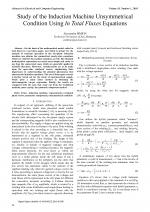| 1/2010 - 6 |
Study of the Induction Machine Unsymmetrical Condition Using In Total Fluxes EquationsSIMION, A. |
| Extra paper information in |
| Click to see author's profile in |
| Download PDF |
Author keywords
induction machine, representative rotational phase vector, symmetric components, unsymmetrical condition
References keywords
simion(12), induction(12), machine(9), electrice(9), timisoara(8), masini(8), phase(7), model(6), livadaru(6), national(5)
Blue keywords are present in both the references section and the paper title.
About this article
Date of Publication: 2010-02-27
Volume 10, Issue 1, Year 2010, On page(s): 34 - 41
ISSN: 1582-7445, e-ISSN: 1844-7600
Digital Object Identifier: 10.4316/AECE.2010.01006
Web of Science Accession Number: 000275458900006
SCOPUS ID: 77954685313
Abstract
On the basis of the mathematical model, called in total fluxes in a previous paper, and which is proper for the analysis of transient operation of the two-phase induction machine, one obtains the symmetrical steady-state equations, which are valid for three-phase machines, as well. The obtained mathematical expressions are much more simple and easier to use than the consecrated ones, which are generally applied in scientific literature. Moreover, considerations are to be made upon the space-time rotational vectors, emphasizing their importance in understanding the physical phenomena that characterize induction machines. The use of these space vectors is further tested out for the study of unsymmetrical supply, which gives a much faster method in obtaining the electromagnetic torque expression. Finally, the results are compared with the ones that come out from the traditional methods, more exactly, the symmetric component method. |
| References | | | Cited By |
Web of Science® Times Cited: 4 [View]
View record in Web of Science® [View]
View Related Records® [View]
Updated 2 days, 17 hours ago
SCOPUS® Times Cited: 5
View record in SCOPUS® [Free preview]
View citations in SCOPUS® [Free preview]
[1] Investigation on Electromagnetic Performance of Induction Motor with Rotor Bar Faults considering Motor Current Signals, PARK, Y.-S., Advances in Electrical and Computer Engineering, ISSN 1582-7445, Issue 4, Volume 20, 2020.
Digital Object Identifier: 10.4316/AECE.2020.04005 [CrossRef] [Full text]
[2] Short review of development approaches of mathematical models for induction motor nonsymmetrical modes research, Dmitriy, Shcherbakov, Vladimir, Polyakov, 2021 XVIII International Scientific Technical Conference Alternating Current Electric Drives (ACED), ISBN 978-1-6654-1248-3, 2021.
Digital Object Identifier: 10.1109/ACED50605.2021.9462311 [CrossRef]
[3] Dual FEM-Simulink analysis of induction motor operating under unbalanced state, Livadaru, L., Simion, Al., Vlasceanu, S., Munteanu, A., Irimia, D., 2012 13th International Conference on Optimization of Electrical and Electronic Equipment (OPTIM), ISBN 978-1-4673-1653-8, 2012.
Digital Object Identifier: 10.1109/OPTIM.2012.6231783 [CrossRef]
Disclaimer: All information displayed above was retrieved by using remote connections to respective databases. For the best user experience, we update all data by using background processes, and use caches in order to reduce the load on the servers we retrieve the information from. As we have no control on the availability of the database servers and sometimes the Internet connectivity may be affected, we do not guarantee the information is correct or complete. For the most accurate data, please always consult the database sites directly. Some external links require authentication or an institutional subscription.
Web of Science® is a registered trademark of Clarivate Analytics, Scopus® is a registered trademark of Elsevier B.V., other product names, company names, brand names, trademarks and logos are the property of their respective owners.
Faculty of Electrical Engineering and Computer Science
Stefan cel Mare University of Suceava, Romania
All rights reserved: Advances in Electrical and Computer Engineering is a registered trademark of the Stefan cel Mare University of Suceava. No part of this publication may be reproduced, stored in a retrieval system, photocopied, recorded or archived, without the written permission from the Editor. When authors submit their papers for publication, they agree that the copyright for their article be transferred to the Faculty of Electrical Engineering and Computer Science, Stefan cel Mare University of Suceava, Romania, if and only if the articles are accepted for publication. The copyright covers the exclusive rights to reproduce and distribute the article, including reprints and translations.
Permission for other use: The copyright owner's consent does not extend to copying for general distribution, for promotion, for creating new works, or for resale. Specific written permission must be obtained from the Editor for such copying. Direct linking to files hosted on this website is strictly prohibited.
Disclaimer: Whilst every effort is made by the publishers and editorial board to see that no inaccurate or misleading data, opinions or statements appear in this journal, they wish to make it clear that all information and opinions formulated in the articles, as well as linguistic accuracy, are the sole responsibility of the author.





